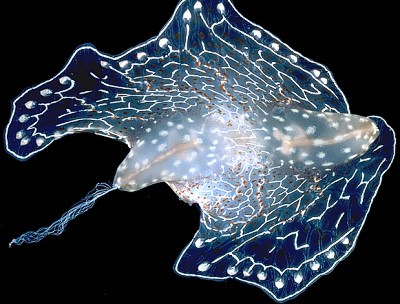
Benthic ctenophores
PHOTO
A benthic ctenophore, Coeloplana sp?. Note partially everted set of tentacles. Off East Point, 6m, Darwin, Northern Territory, Australia. June 1987. PHOTO: Bill Rudman.
Ctenophores, commonly called Comb Jellies or Sea Gooseberries, were previously considered to be Cnidarians, because like jelly fish and sea anemones, ctenophores also have nematocysts. Today they are considered to represent a separate Phylum, the Ctenophora. Most are pelagic animals, spherical in shape, which swim by bands of large beating cilia, arranged in vertical rows, each band being likened to comb, hence the name "Comb Jelly". The 'jelly' is a reference to Jelly Fish. Ctenophores catch their prey by everting two groups of stinging and sticky tentacles.
There are however a small group of ctenophores [Platyctenida] which have evolved into benthic 'slugs'. At first glance they are usually considered to be flatworms, but if you look at them carefully you will find a pair of pores or swellings which indicate the chambers in which are stored the stinging tentacles. Quite often found on soft corals, like acoel flatworms, there are only a few described species, but probably many yet to be recognised. Most are less than 10-15mm long.
See report of aglajid opisthobranch eating a benthic ctenophore [message #15543 ]
Authorship detailsRudman, W.B., 1999 (November 25) Benthic ctenophores. [In] Sea Slug Forum. Australian Museum, Sydney. Available from http://www.seaslugforum.net/factsheet/ctenopho
Related messages
-
Benthic ctenophores from Bali
From: Supapong Areeprasertkul, October 27, 2008 -
Benthic ctenophore from Bali
From: Ovidiu, June 20, 2006 -
Re: Aglajid eating a benthic ctenophore
From: Brian Francisco, January 14, 2006 -
Can you identify this one?
From: Karen Christensen, January 12, 2006 -
A benthic ctenophore from the Philippines
From: Mabel Fang, February 24, 2004 -
An organism on Caulerpa prolifera
From: Levent Cavas, December 19, 2003 -
What is this 'red thing' on Halgerda?
From: Valda Fraser, November 26, 1999
